Welcome! You’re probably here because you’re wondering how to go plant-based. Maybe because you’ve heard about the many health benefits? Or environmental benefits? Or maybe you just want to cut down a little on your meat consumption.
Whatever the reason, you are not alone! 🌱
In fact, one in four Americans report eating less meat in the past year than they had previously.
In March 2020, it was reported that grocery sales of plant-based foods that directly replace animal products grew 29% in the past two years.
But, why this change? Science tells us that moving to a plant-based diet (or “plant-forward” diet) is a powerful way to improve our health, boost our energy levels, help with weight management, and prevent chronic diseases, all the while helping the environment.
Sounds great, doesn’t it?
But we all know that embarking on any new dietary journey can be a bit intimidating and overwhelming. Where do you start? And how do you start? How do you replace your favorite meals? How do you swap out lifelong eating habits for complete new ones? Is there a way to make this an enjoyable process, instead of a daunting one?
If you have all of these questions swirling around your head right now, and are wondering how to transition to a vegan diet, don’t worry! You’re in the right place.
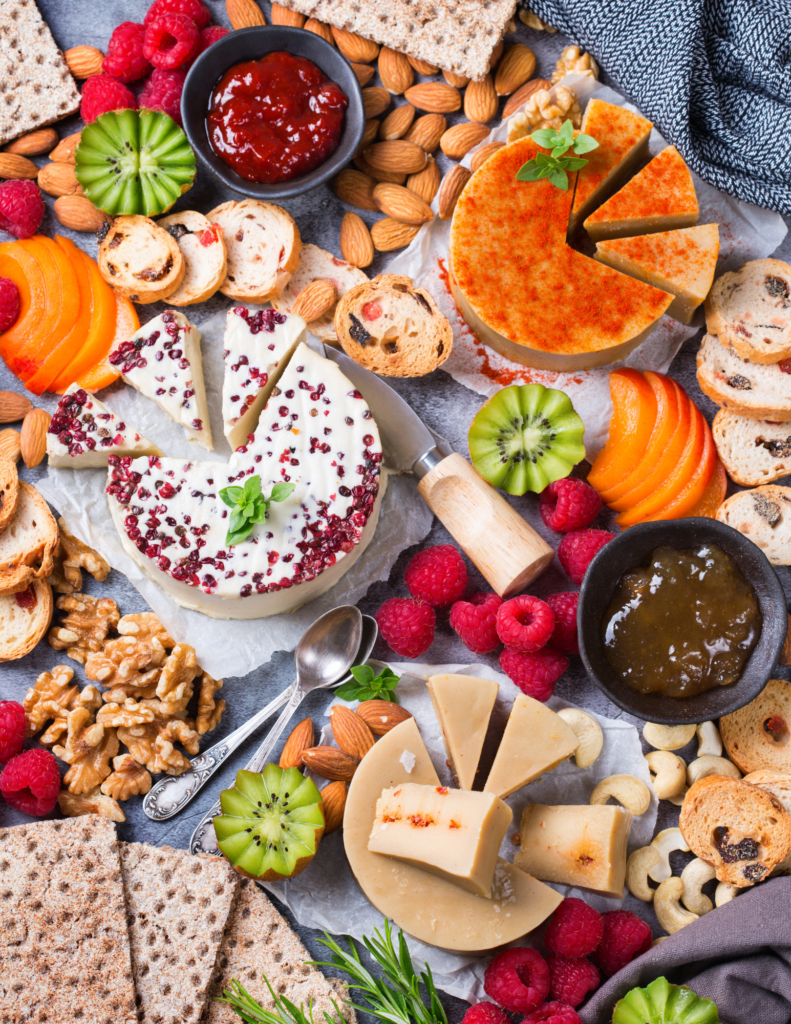
The key to long-term success: don’t try to do it overnight! Small, smart steps are the best way to ensure long-lasting changes. And, remember—moving to a plant-based diet (or plant-forward diet) doesn’t mean you need to become strictly vegan, and can never eat meat or dairy again. It doesn’t mean your social life is over (this was one of my personal fears).
This is about choosing to incorporate more foods from plant sources into your diet, at whatever capacity you feel comfortable with. Want to go 100% plant-based? Great! Want to go 50% plant-based? Great, too!
We highly encourage you, no matter how motivated you might feel, to move at whatever speed feels comfortable and sustainable. This isn’t a race. There is no finish line. Every single positive step you take counts and deserves to be celebrated.
You decide at what speed you want to move, and how far you want to go!
Here’s The Regular Person’s Guide to a Plant-Based Diet.
Table of contents
- What Is A Plant Based Diet Anyway?
- Plant-Based Vs. Vegan?
- Vegan Vs. Vegetarian?
- The 9 Key Benefits Of Eating More Plants In Your Diet
- Try Your Favorite Meals, But With More Plants
- A One-Day Example Of Plant Based Eating
- How To Build a Plant-Based Grocery List
- What’s The Deal With Protein? Can You Get Enough Protein On A Plant-Based Diet?
- Isn’t A Plant-Based Diet High In Carbs? Won’t I Gain Weight?
- How To Transition To A Plant Based Diet
- What Supplements Do You Need On A Plant-Based Diet?
- 9 Mistakes To Avoid On A Plant-Based Diet
- How Do I Handle Social Events And Holidays?
- Start Your Journey Today!

What Is A Plant Based Diet Anyway?
A plant-based diet is defined as one that consists mostly (or entirely) of plant-derived foods, and minimizes (or eliminates) animal products. Basically, it’s a diet focused on maximizing calories from whole, or minimally processed, plants.
Plant foods include fruits, vegetables (including tubers), whole grains, nuts, seeds, oils, legumes. Here are some examples:
- Fruits: any type of fruit including berries, apples, bananas, pineapples, citrus fruits, etc.
- Vegetables: any type of vegetable including mushrooms, bell peppers, tomatoes, avocados, broccoli, artichokes, lettuce, spinach, kale, etc.
- Tubers: any root vegetable including potatoes, sweet potatoes, carrots, radishes, beets, etc.
- Whole grains: any grain or cereal, including brown rice, quinoa, millet, amaranth, whole wheat, oats, rye, buckwheat, barley, spelt, corn (and popcorn!), whole grain breads and pastas, etc.
- Nuts: any type of nut including, almonds, peanuts, macadamia nuts, hazelnuts, cashews, pecans, pistachios, etc.
- Seeds: any type of seed including chia seeds, pumpkin seeds, sunflower seeds, hemp seeds, flax seeds, sesame seeds, poppy seeds, etc.
- Oils: not all plant-based eaters consume oil, but if you’d like to include it in your diet, our favorites are olive oil, avocado oil, macadamia oil, walnut oil, flaxseed oil, hemp seed oil
- Legumes: includes all beans, lentils, peas, etc., as well as foods derived from beans (like tofu and tempeh from soybeans).
There are plenty of other foods you can enjoy too, including plant-based alternatives to your favorite foods! Think: plant-based milk, plant-based cheese, plant-based meat, etc.
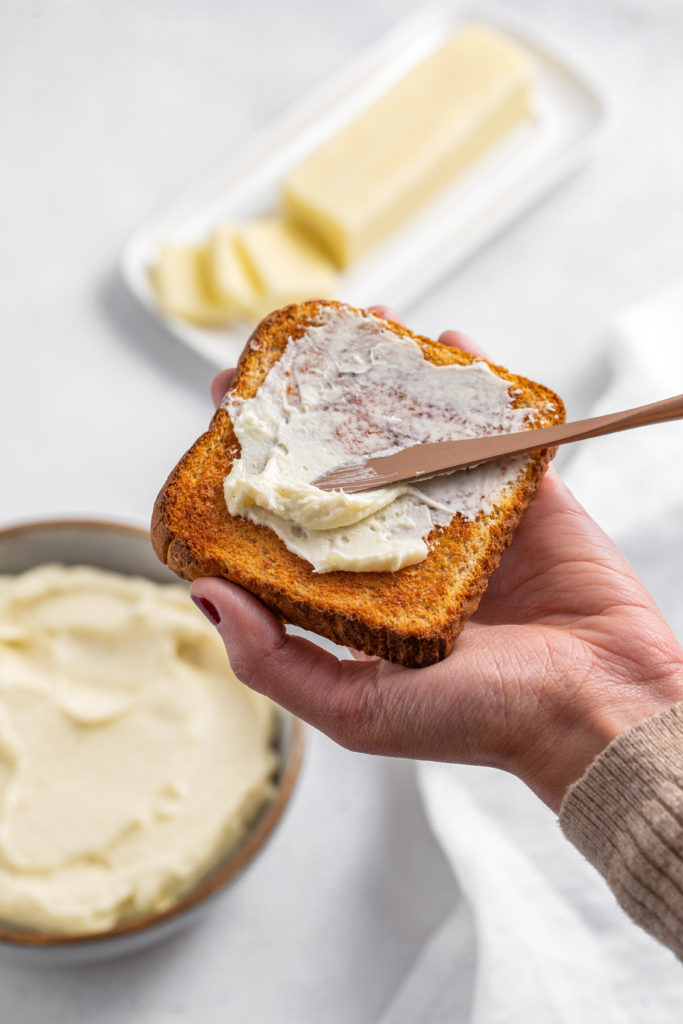
But, while there are plenty alternatives to choose from, it’s important to note that many of these alternatives aren’t exactly healthy.
If you were attracted to a plant-based diet because of the health benefits, you’ll want to focus on consuming foods in their most natural form. When purchasing groceries, focus on fresh foods. When purchasing foods with a label, aim for those with the fewest ingredients.
Avoid heavily processed foods like these:
- Refined grains: white rice, white pasta, white bread, etc.
- Fast food: cheeseburgers, hot dogs, french fries, etc.
- Packaged and convenience foods: chips, cereal bars, etc.
- Artificial sweeteners: Splenda, Sweet’N Low, etc.
- Added sugars: always check the ingredient list when purchasing foods, and avoid those with added sugar
- Unhealthy sweet treats: donuts, cakes, pastries, cookies, candy, some cereals, etc.
- Highly processed vegan-friendly foods: many plant-based cheeses, meats, etc. are loaded with unhealthy ingredients, but there are also healthier ones to choose from!
- Sweetened beverages: soda, energy drinks, sports drinks, sweetened tea, etc.
- Processed animal products: sausage, beef jerky, deli meats, etc.

Plant-Based Vs. Vegan?
Wondering what the difference is between a plant-based diet and a vegan diet?
There are so many dietary labels today, and sometimes their meanings can be pretty subjective. To some, a plant-based diet might mean one thing, and to another, something slightly different.
To keep things clear and simple, the definitions in this article reflect what is used in scientific literature, not social media!
As mentioned above, a plant-based diet can be used to refer to:
- A diet that consists of 100% of calories coming from plants, as well as…
- A diet that consists of most (but not all) calories coming from plants.
Some people like to differentiate between the two by referring to their diets as “plant-exclusive”, meaning option number 1, or “plant-predominant” / “plant forward”, meaning option number 2.
A vegan diet, on the other hand, excludes all animal products, including meat, seafood, dairy, eggs, and honey. While this sounds like option number 2 mentioned above, the difference is that vegan diets can technically include potato chips, Oreos, and other highly processed junk food items.
Therefore, it’s important to note that “vegan” does not automatically mean healthy, whereas a whole-food, plant-based diet implies a focus on healthy, whole foods.
Aside from the food aspect, vegans also commit to this lifestyle in all other aspects of their lives, for example: no wool clothing, no down comforters, no leather boots, etc.

Vegan Vs. Vegetarian?
Now we know that a vegan diet refers to a diet that excludes all animal products.
A vegetarian diet also excludes eating meat, but may contain other animal products, like eggs, dairy, and honey.
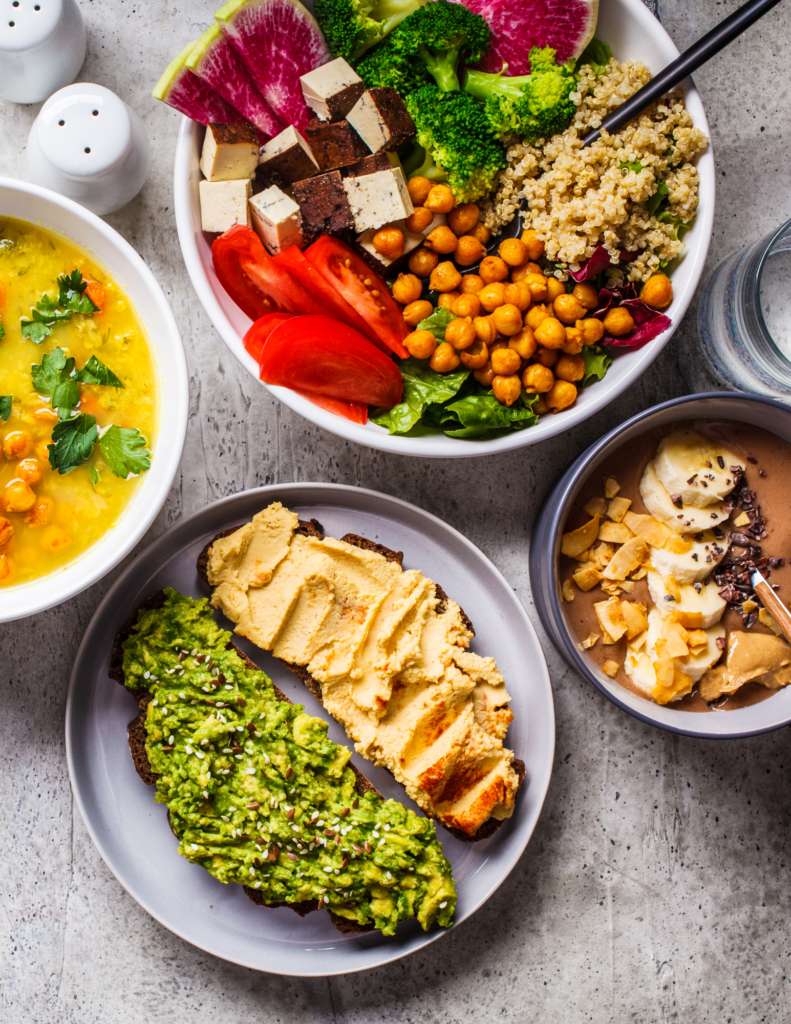
The 9 Key Benefits Of Eating More Plants In Your Diet
Science doesn’t lie, and it tells us that there are several benefits to eating a predominantly plant-based diet, including:
- Easier weight management
- Healthier cellular aging
- Improved overall health (may lower blood pressure and cholesterol)
- Improved immunity
- Disease prevention (and sometimes, reversal)
- Better gut health
- Reduced inflammation
- Increased energy
- Reduced environmental footprint
In fact, have you ever heard of the Blue Zones? Blue Zones are places around the world where people live the longest, and are the healthiest. They were discovered by National Geographic Fellow And New York Times bestselling author, Dan Buettner.
The 5 Blue Zones are:
- Okinawa, Japan
- Sardinia, Italy
- Nicoya, Costa Rica
- Ikria, Greece
- Loma Linda, California
What do these places have in common? They all share several specific lifestyle habits, one of which includes eating predominantly plant-based diets. Meat is eaten on average only 5 times per month, and serving sizes are 3-4 oz.
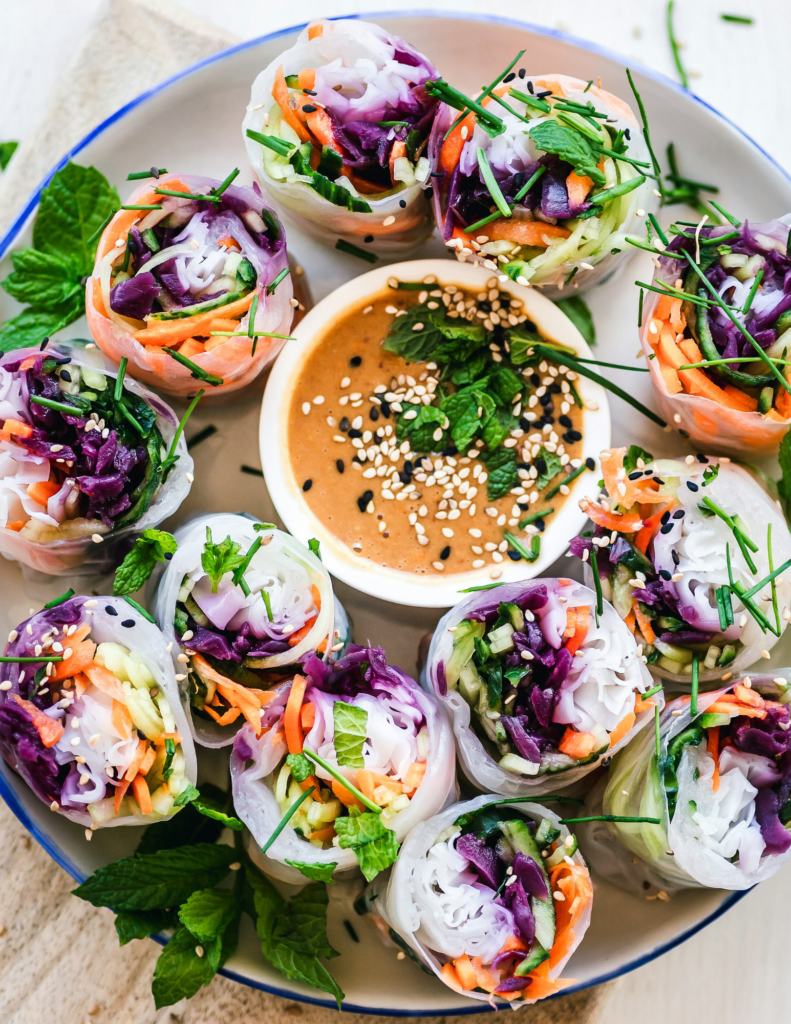
Let’s hear more about the health benefits experienced by others:
Remy Morimoto Park, creator of @veggiekins and veggiekinsblog.com says:
“I initially went vegan because I suspected that I had a dairy allergy. I used to struggle with stomach aches most nights so I decided to cut out dairy for an entire week. Immediately, I felt the difference, and overall my digestion improved as well!”
“Many of the dairy free recipes that I tried online happened to also be vegan, and that was my first introduction to veganism as a concept. The following week I decided to try a fully vegan diet, and again felt an incredible physical change. I felt very energetic, never sluggish after meals, and that was it for me! I never went back.”
“Later on, I learned more about veganism as a lifestyle and the ethical and environmental reasons helped me to fully embrace the vegan lifestyle. Health aside, two of my favorite things about eating vegan are 1) you can eat raw cookie dough and batter safely – no need to worry about raw eggs, and 2) My grocery bill on average is much lower than it used to be before going vegan. I used to rely a lot on meat, dairy and eggs which would bump up my grocery bill. Now my diet is primarily whole food plant based, and plant based foods can be some of the most affordable foods.”
Nisha Vora, creator of @rainbowplantlife and rainbowplantlife.com, says:
“I decided to stop eating meat in 2016 after noticing that I felt weighed down when I did. Immediately, I felt lighter and happier, so I started investigating veganism. I loved cheese and ice cream though, so it didn’t seem doable. But then I binge watched several documentaries on factory farming that showed me how awful the animal agriculture business is both for the innocent animals as well as for the environment.”
“A light switch went off in my head and I became vegan overnight. Going vegan has helped me to live a life that’s fully aligned with my morals and beliefs and my desire to spread compassion and to help those who don’t have a voice.”
“It’s also helped me become a better cook, as I’ve become so much more creative in the kitchen without being able to rely on dairy and meat. I used to cook the same chicken breast and same omelet every week, but now that I’m more familiar with the abundant world of plant ingredients, I cook and eat new types of food on an almost daily basis.”
“I was in fairly good health before going vegan, but also experienced some benefits I didn’t anticipate. My hereditarily high cholesterol has dropped 75 points, and my migraines and IBS symptoms have all but disappeared.”
📢 Remember, as mentioned above, YOU decide at what speed you want to move, and how far you want to go! You do not need to go 100% plant-based in order to start experiencing some of these benefits.

Try Your Favorite Meals, But With More Plants
Want to dip your toes in the water?
Here are some popular meals made only with plants:

A One-Day Example Of Plant Based Eating
Interested in going further?
Here’s a walkthrough of a day’s worth of plant-based meals!
Breakfast:
- Oatmeal made with plant-based milk, topped with mixed berries, and nuts and seeds of choice
- Breakfast wrap with a whole-wheat tortilla, scrambled tofu, black beans, peppers, onions, guacamole, and salsa
- Strawberry banana smoothie with plant-based milk, nut butter and hemp seeds
Snack:
- Apple with peanut butter
- Guacamole or salsa with tortilla chips or veggies
- Homemade granola
Lunch:
- Tacos filled with black beans, guacamole, lettuce, and pico de gallo (you can also add crispy ground tofu for extra protein)
- Poke bowl loaded with quinoa, tofu, greens, seaweed salad, edamame, pickled ginger, avocado, crispy nori, and sesame seeds, topped with an Asian vinaigrette
- Chickpea ratatouille with brown rice
Snack:
- Hummus and veggies (or whole wheat pita bread)
- Edamame with sea salt
- Popcorn with nutritional yeast (for cheesy flavor)
Dinner:
- Lentil pasta with pesto sauce
- Grilled tofu and vegetable kabobs with homemade BBQ sauce, crispy potatoes, and a side salad
- Smoky tempeh black bean burgers
Dessert:
- Dark chocolate with strawberries
- Plant-based ice cream (check out our favorite store-bought options)
- Stuffed dates (my two favorite stuffings are chocolate peanut butter, and peanut butter and jelly)
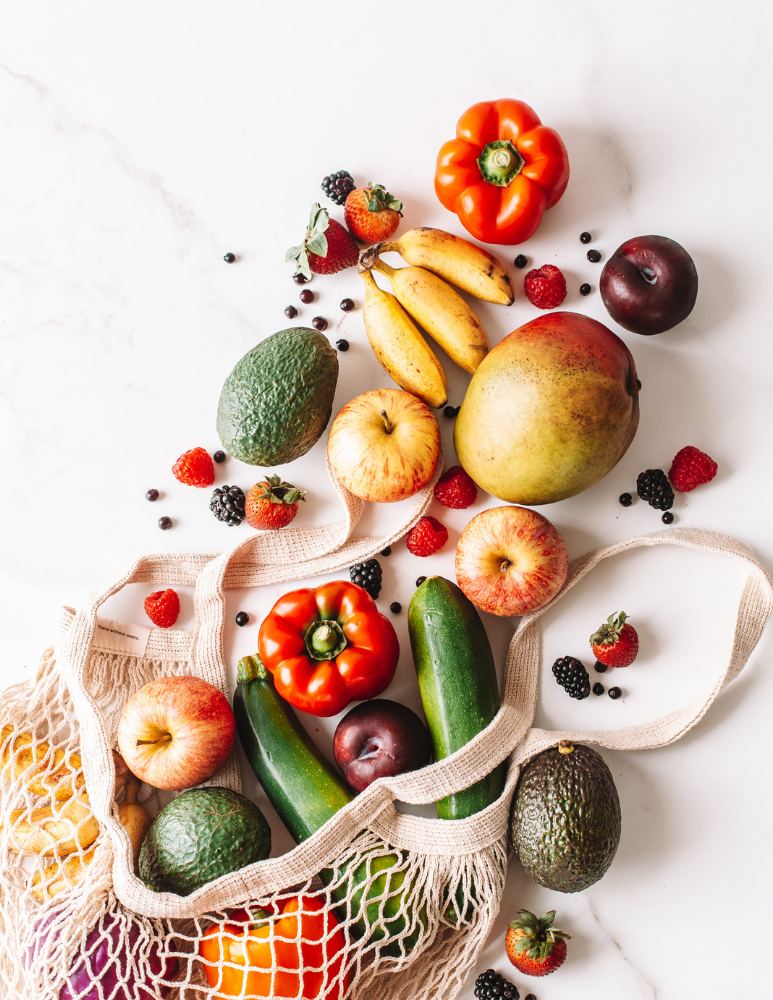
How To Build a Plant-Based Grocery List
Building a plant-based grocery list is actually a lot simpler than it may seem. Here’s how we shop!
Refrigerated foods: fresh fruits and vegetables of choice, tofu, tempeh, spreads (like hummus, guacamole, etc.), plant-based milk, plant-based cheese, plant-based yogurt, sauerkraut, kimchi, fresh herbs, flavorings (like curry paste, healthy sauces/dressings, etc.)
Freezer foods: frozen fruit, veggie burgers and other meat replacements, whole-grain bread, whole-grain tortillas, plant-based ice cream
Pantry foods: rolled oats, brown rice, quinoa, millet, potatoes, lentil pasta (or other healthy pasta varieties), tomato sauce, canned beans of choice, nuts and seeds of choice, nut and/or seed butters of choice, dark chocolate, baking items, snacks (like healthy crackers, popcorn, etc.), oils, vinegars, dried herbs and spices, unopened condiments (like soy sauce, mustard, etc.), unopened vegetable stock, nutritional yeast, seaweed, whole-grain taco shells
Beverages: tea, coffee, kombucha, sparkling water, regular water
Don’t worry – we made this extra simple for you. Download a copy of our plant-based grocery list to help you structure your next trip to the grocery store!
What’s The Deal With Protein? Can You Get Enough Protein On A Plant-Based Diet?
Just about everyone talks about protein and how to get more of it. Protein bars, protein snacks, protein drinks… they’re all over the place. This makes us think of protein as the king of nutrients. Is it? No!
Contrary to popular belief, you can get more than enough protein on a plant-based diet. Many people actually consume too much protein, yet they’re always trying to eat and drink more of it. I know, I was one of them. I personally spent years of my life thinking I needed way more protein than I actually did.
Studies show us that most adults need no more than 0.8-1.0g of protein per KG (not lb) of bodyweight per day, or 1.6-2.2g per KG of bodyweight per day for bodybuilders, athletes, etc.
The specific number entirely depends on the individual (activity levels, goals, age, weight, etc.), so it’s always best to consult a dietitian or nutritionist to get personalized recommendations.

But, the point is – there’s no need to be overly concerned about getting enough protein on a plant-based diet. Even so, here are the best plant-based sources of protein for you to know:
- Tofu, tempeh, edamame, soy milk, and other soy products
- Legumes (like lentils and chickpeas)
- Nuts (like peanuts, almonds, and pistachios)
- Seeds (like chia seeds, pumpkin seeds, and hemp seeds)
- Whole grains (like quinoa, amaranth, whole wheat pasta)
- Seitan
- Nutritional yeast
- Spirulina
- Some alternative flours (like chickpea flour, almond flour, etc.)
Here are our 14 favorite protein-rich snacks:
- Rice cakes with nut butter
- Chia pudding
- Soy yogurt with fruit
- Homemade granola
- Homemade trail mix
- Chickpea cookie dough
- Energy bars/balls
- Hummus with veggies or bread
- PB and J on wholegrain bread
- Protein shakes that include things like soy milk, nut butter, and seeds
- Any bean dip with veggies or healthy crackers
- Edamame
- Protein chocolate mousse (made with tofu as the base)
- Crunchy roasted chickpeas
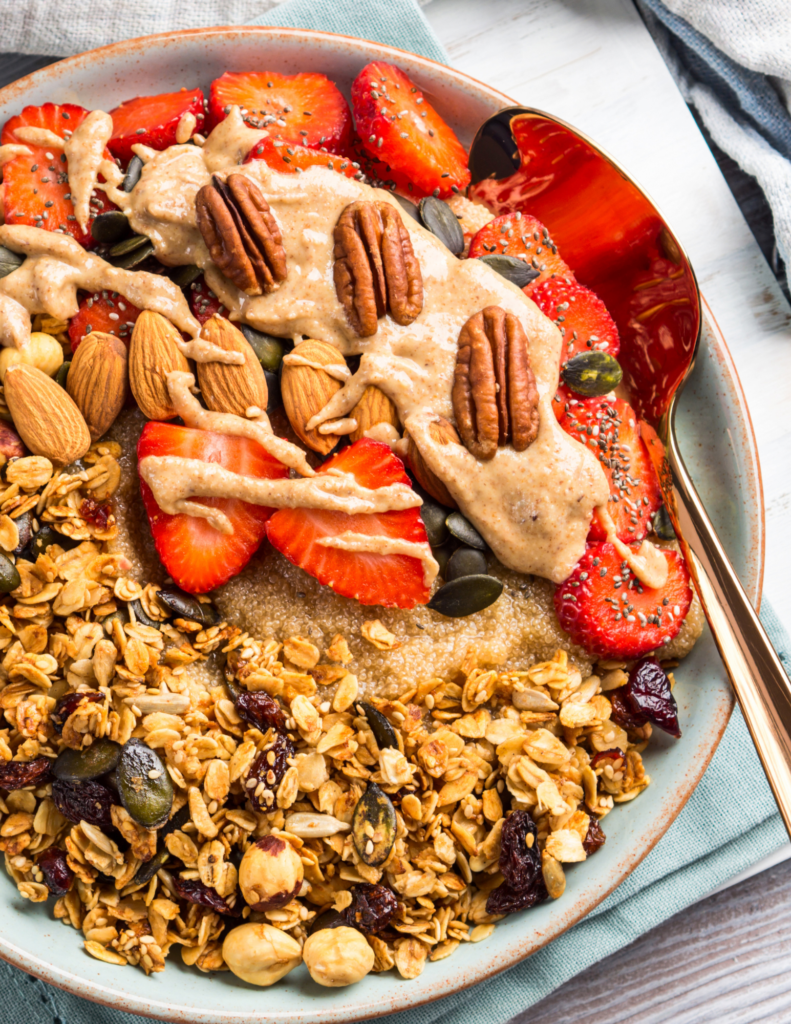
Isn’t A Plant-Based Diet High In Carbs? Won’t I Gain Weight?
Carbohydrates are a macronutrient – one that has been demonized for years! There is no reason to fear them, and there is no reason to cut them out of your diet.
But, more importantly, when talking about carbs, let’s not lump them all into the same category. Brown rice and oats are VERY different from potato chips and donuts.
If we’re talking about refined, processed carbohydrates, like white bread, traditional pastries, and pizza (to name a few), then YES – you can get rid of them.
But, these refined carbohydrates should definitely not be lumped in with fiber-rich whole grains, legumes, fruits, vegetables, nuts, and seeds (which all contain carbs). These benefit your health! They feed and nourish the healthy microbes in your gut. Plus, they help regulate blood sugar and cholesterol, reduce insulin levels, and more.
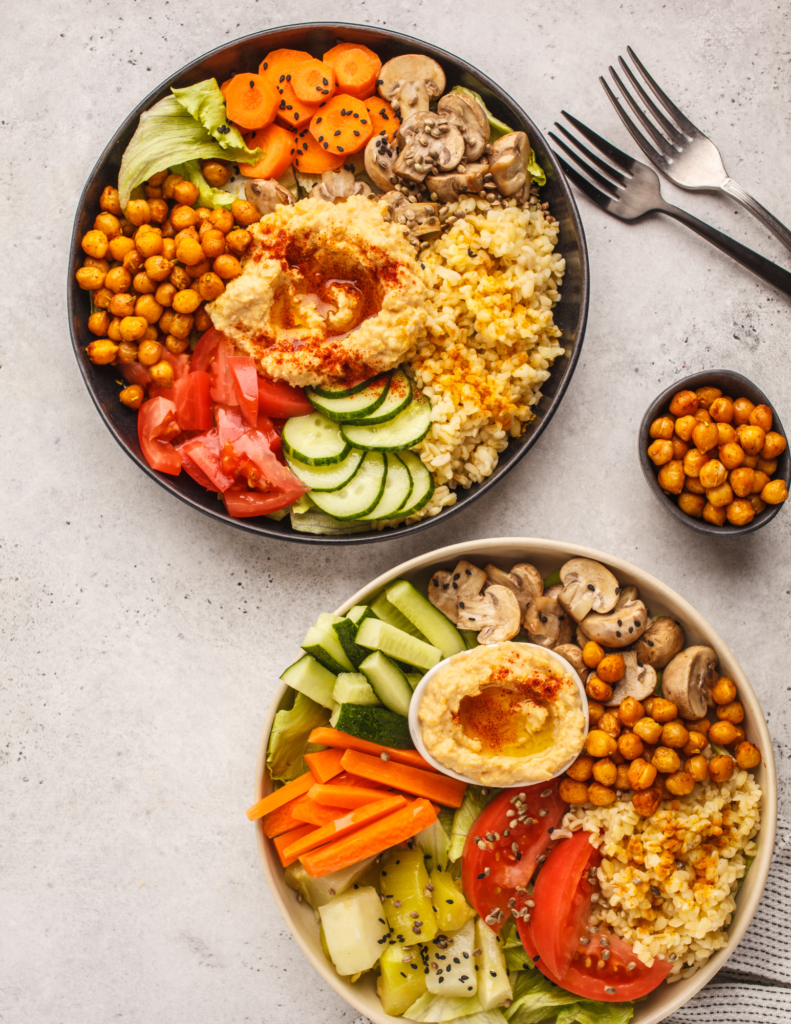
How To Transition To A Plant Based Diet
- Change your mindset about food. It’s easy when starting a plant-based diet to think about what you’ll be missing out on, rather than what you’ll be gaining. This way of eating shouldn’t be about deprivation or willpower. It should be about abundance and satisfaction! I am completely confident that once you learn more about plant-based eating, and the ins and outs of plant-based alternatives to your favorite meals, you’ll fall in love with the plant-based lifestyle, and more importantly, how it makes you feel.
- Start small. Think about this as a lifestyle change, not a fad diet to lose weight in 30 days! It’s best to start with small changes, and move at whatever pace you feel comfortable. For example, try making one meatless meal every other day. A warm bowl of oatmeal for breakfast, or a bean taco for lunch, or a poke bowl for dinner. As you get more comfortable, if you feel you want to go further, try making one meatless meal every day instead of every other day. Then, two meals per day, and so on. Another way to start small is to cut out one group of animals at a time. For example, you could start by cutting out 4-legged animals. Then, if you feel you want to go further, you can cut out 2-legged animals, then seafood, and so on. Another way to start small is to make a few swaps! For example, swap cow’s milk for almond milk or soy milk. Swap dairy cheese for plant-based cheese, and so on. These are just a couple suggestions for starting small, but there isn’t one perfect way to start small!
- Create the right environment. We recommend doing a “cleaning” of your kitchen (cupboards, pantries, etc.) to remove any unwanted foods that will make it harder for you to stick with it. These unwanted foods are way too tempting when we’re in a rush, and can’t be bothered to prepare something healthier. Try replacing your favorite snacks with plant-based alternatives, especially at the beginning. This will help the process feel a lot easier.
- Buy some new cookbooks. Using plant-based cookbooks is not only a great way to learn some new recipes, but it’s also an amazing way to look for ideas and get inspired when planning meals. You can also browse recipes on Pinterest, Instagram, Tik Tok, and plant-based food blogs!
- Know your safe spots. We highly recommend knowing the nearest plant-friendly restaurants in your area. So, when you find yourself hungry (and don’t feel like cooking), you know exactly where to go (or order from). Check out the website and app called Happy Cow – it lists all the vegan restaurants nearby! We also recommend finding the healthiest local grocery shops, as they tend to stock up on the most plant-based alternatives to your favorites!
- Keep it simple, but aim for variety. The easiest way to do this? Think: whole foods! Focus on eating a wide range of fruits, veggies, whole grains, legumes, nuts and seeds. It’s that simple. An easy way to aim for variety is to try a new recipe every week! It’s easy to start remaking your favorite meals over and over again, but trying new recipes can force us to include new plants in our regular diet. Before you know it, you’ll have a long list of plant-based meals and snacks to choose from.
- Plan ahead. A little planning and preparation can make your life so much easier! Choose some new recipes you’d like to make that week, and grocery shop for the whole week, so there isn’t too much guessing at the last minute. Another way we love to meal prep is to batch cook for a couple days! This can be as simple as preparing several starches (exs: potatoes, brown rice, and quinoa), or preparing tofu 3 ways (exs: BBQ, teriyaki, and coconut curry). You can take things a little further and make a couple full meals in bulk so you have some leftovers to last a few days!
- Educate yourself. At the beginning, plant-based eating can seem very overwhelming. But, there are lots of great resources out there to help you learn more about health and nutrition! Think books, podcasts, cookbooks, and more.
- Get some support. Creating or joining a support network to go on this journey with, can make all the difference in the world! The Internet is a great way to connect with other like-minded people. Think Facebook groups, and awesome plant-based Instagrammers! Fill your social media pages with inspiring pages that share lots of information on plant-based eating and living!
- Stick with it. Remember that this isn’t a race. There is no finish line. This transition might happen quickly, or it might take some time. You might decide to go 100% plant-based, or you might decide 50% is more your speed. Either way, it’s OK! The best thing you can do is think of this as a lifestyle, and set realistic, attainable goals for yourself that you can see yourself sticking to. Aim to stay on track for 30 days, and see how you feel! Studies show that it takes an average of 66 days to form a new habit, or for a new behavior to become automatic. So, after 30 days, you’re halfway there!
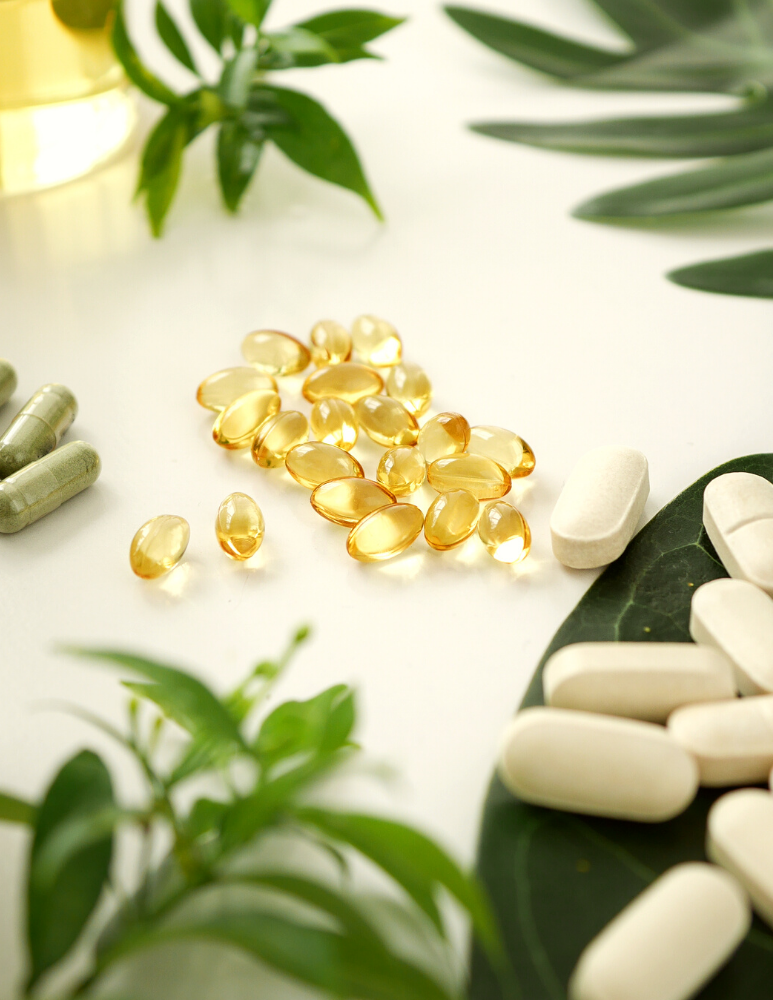
What Supplements Do You Need On A Plant-Based Diet?
For anyone limiting or reducing their animal product intake, it’s recommended to supplement with the following:
- Vitamin B12 – Did you know that B12 is actually produced by bacteria in the soil? Not animals or plants! In fact, livestock are often supplemented with vitamin B12 in their feed, so whether we know about it or not, most people are getting their B12 from a supplement, anyway. But, because plant-based eaters are essentially cutting out the “middle-men” (livestock), supplementing this is non-negotiable for anyone following a plant-based diet. B12 is essential for forming red blood cells, cell metabolism, nerve function, and producing DNA.
- Omega 3s from algae (DHA/EPA) – Did you know that fish cannot produce omega 3? They actually get omega 3 from seaweed and algae! Again, because plant-based eaters are cutting out the “middle-men” (fish), supplementing these nutrients is recommended. Omega 3s play a key role in the development of the brain and eyes. They can fight inflammation, autoimmune diseases, and improve risk factors for heart disease. They are also good for your skin, and may help with weight management.
- Vitamin D (for everyone, not just vegans) – This is essential for increasing calcium and phosphorus absorption to help promote healthy bones. Elsewhere, vitamin D also influences the immune system, intestines, heart, muscles, brain, and pancreas. About 1 billion people worldwide have vitamin D deficiency, while 50% of the population has vitamin D insufficiency.
For most people, if you are eating a well balanced, whole-food, plant-based diet, the above three supplements should be enough. However, other supplements might be recommended based on your particular blood test. Some other supplements to consider are: iodine, iron, calcium, selenium, and zinc. Ultimately, supplements are best guided by a dietician, nutritionist, and/or a doctor!
Check out our guide on supplementing on a vegan diet to see recommended dosages, our brand favorites, and more!

9 Mistakes To Avoid On A Plant-Based Diet
More than anything, the purpose of this article is to make sure you’re completely set up to start your plant-based journey! But, with any new undertaking, mistakes can seem inevitable. So, we’re here to help you skip those mistakes many people make on their plant-based journey, and help you feel prepared.
Here are some common mistakes plant-based beginners make, and how to avoid them:
Mistake #1: Undereating. Lots of people think that being vegan means drinking celery juice for breakfast, and eating simple salads for lunch and dinner. But, what does this do? It leads to feelings of deprivation, which then leads to intense cravings and binge-eating unhealthy foods. Don’t be afraid to include more filling foods, like potatoes, brown rice, beans, avocado, nuts, seeds, and more! Our bodies need quality sustenance that can provide us with plenty of nutrients and enough calories.
Mistake #2: Too much, too fast. Because many foods and food groups are off limits to plant-based eaters, it can feel challenging in the beginning. Transitioning too quickly can lead to unintentionally undereating, frustration with what to eat, feelings of failure, and giving up. By transitioning to a plant-based diet, you’re basically learning about a new way of eating! This can take time, and that’s OK. Be patient, and move at a comfortable pace.
Mistake #3: Assuming that vegan products are automatically healthier. Many foods at the grocery store are marketed as vegan, but are also highly processed, high in sugar, high in saturated fat, and/or lacking in nutrients. Don’t make the mistake of falling for marketing tricks. Instead, read the ingredient labels, and stick to mostly nutritious, whole foods.
Mistake #4: Not eating enough protein. This mistake should not be confused with the myth of not being able to get enough protein. While there are TONS of plant-based protein options out there, it can be easy at the beginning to get confused and assume something has the same amount of protein as its non-vegan alternative. For example, foods like jackfruit, vegan cheese, and almond milk are all common replacements for meat and dairy products, but actually contain very little protein. Take time to familiarize yourself with good vegan protein sources and include enough of them in your daily diet!
Mistake #5: Spending too much money on vegan alternatives. At the beginning especially, it’s exciting to check out all the new vegan products, like vegan cheeses, vegan butters, vegan ice creams, vegan cookie dough, vegan pizza, and more. But, you’ll soon realize that it adds up pretty quickly. Don’t get me wrong, vegan alternatives can be amazing! They’re delicious, easy, and convenient, and some are healthy, too. However, eating them all the time can definitely add quite a bit to your grocery bills. Remember that there are plenty of natural, plant-based foods that are super inexpensive, like fruits, veggies, legumes, and whole grains.
Mistake #6: Not supplementing properly. Vegans and vegetarians are at a greater risk of vitamin B12 deficiency due to the fact that we cut out the middlemen from our diets (see above in: What Supplements Do You Need on a Plant-Based Diet?). So, make sure to consume B12-fortified foods or take B12 supplements! Aside from B12, I listed a few other supplements to take into consideration above.
Mistake #7: Not planning accordingly. Eating plant-based requires some extra planning in the beginning. Meal planning can help ease the transition and make it easier to stick to. Unfortunately, refined carbohydrates, like white pasta and white bread often end up as staples in a poorly planned plant-based diet. Plant-based recipe books can help with this! And, if you decide to eat out, look at the menu beforehand to avoid feeling blind-sided, pressured, and stressed when there.
Mistake #8: Getting stuck in a food rut. When you first transition to a plant-based diet, it’s easy and tempting to stick to the exact same foods. But, don’t forget that with a plant-based diet, you need variety in order to get all the nutrients and vitamins you need! Not to mention, sticking to the same foods will bore you really quickly
Mistake #9: Not drinking enough water. While this is true for most people, it’s especially important for those who eat fiber-rich diets, like plant-based eaters! Drinking water with fiber is important because it helps the fiber move through the digestive tract, and can help prevent gas, bloating, and constipation.
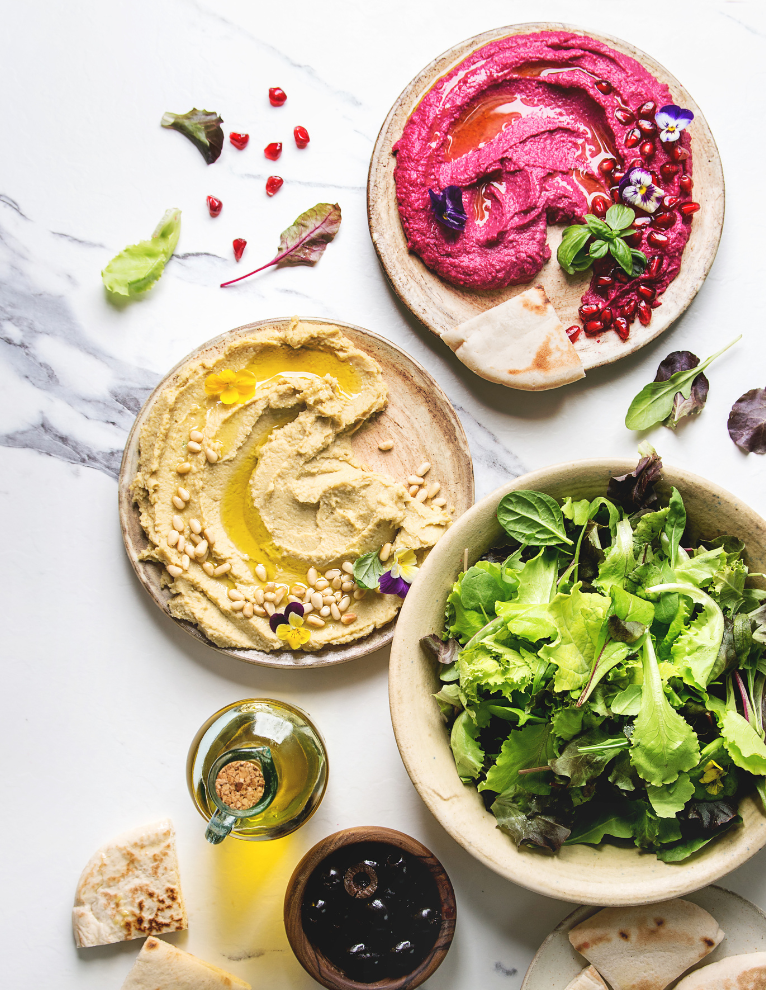
How Do I Handle Social Events And Holidays?
We get it. Holidays in particular can be overwhelming when you’re plant-based. For example, some of us have families and friends who aren’t exactly “understanding”, which makes things even more difficult and awkward. There are a few things you can do, though, to make these situations as close to “normal” as possible!
- Bring food to share. I always show up to social gatherings with plant-friendly options to share, whether it’s appetizers, a main, or a yummy vegan dessert. It’s a great way to avoid imposing your eating habits on anyone, and is a great opportunity to amaze your friends and family with delicious plant-based food!
- Reach for the plant-friendly appetizers. Think hummus, guacamole, nuts, and any other plant-based option you can find.
- Cheat. If you aren’t planning to be 100% plant-based, you can make holidays and/or social gatherings one of those opportunities to “cheat”. There is no right or wrong way to be plant-based or plant-forward. We know many plant-based munchers who “cheat” during the holidays, and still maintain a healthy, plant-based (or plant-forward) diet throughout the rest of the year. If this sounds good to you, it’s OK.

Start Your Journey Today!
Hopefully this article has helped you feel comfortable enough to get started on your plant-based journey. Remember, this is a lifestyle, not a fad diet. In short, this is about choosing to incorporate more foods from plant sources into your diet, at whatever capacity you feel comfortable with.
Every small step you take is a powerful one! There’s no need to rush or feel pressured to become 100% plant-based. This doesn’t have to be all or nothing. This lifestyle is whatever YOU want it to be. Take things one day at a time, with one meal at a time.
If you have any questions or need any help along the way, please feel free to reach out, and follow us on Instagram, TikTok, and Facebook for more tips, recipes, and info on plant-based living.
References:
https://news.gallup.com/poll/282779/nearly-one-four-cut-back-eating-meat.aspx
https://www.gfi.org/marketresearch
https://www.ncbi.nlm.nih.gov/pmc/articles/PMC5466943/
https://academic.oup.com/aje/article/187/10/2192/5038505
https://www.everydayhealth.com/diet-nutrition/scientific-benefits-following-plant-based-diet/
https://jamanetwork.com/journals/jamainternalmedicine/article-abstract/2738784
https://www.healthline.com/nutrition/7-supplements-for-vegans
https://www.nomeatathlete.com/supplements/ https://www.healthline.com/nutrition/vegetarian-and-vegan-mistakes

